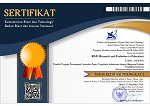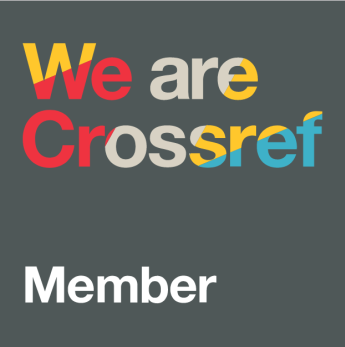Separation index and fit items of creative thinking skills assessment
DOI:
https://doi.org/10.21831/reid.v2i1.8260Keywords:
PCM-1PL, separation index, fit item, creative thinking skills, conation aspectAbstract
References
Adams, R.J. & Khoo, S. (1996). Acer quest (2.1). Camberwell, Victoria: Australian Council for Educational Research.
Alagumalai, S., Hungi, N., & Curtis, D.D. (2005). Applied Rasch measurement: A book of exemplars - papers in honour of John P. Keeves. Dordrecht: Springer.
Baer, M. (2012). Putting creativity to work: The implementation of creative ideas in organizations. Academy of Management Journal, 55(5), 1102-1119.
Bhakta, B., Tennant, A., Horton, M., Lawton, G., & Andrich, D. (2005). Using item response theory to explore the psychometric properties of extended matching questions examination in undergraduate medical education. BMC Medical Education, 5(9). Doi: 10.1186/1472-6920-5-9.
Board of National Education Standard. (2010). Panduan penulisan butir soal [Handbook of writing questions item]. A material of technical guidance on school-based curriculum and 2010-standardized questions]. Jakarta: Badan Standar Nasional Pendidikan.
Boden, M.A. (2001). Creativity and knowledge. In A. Craft, B. Jeffrey, & M. Leibling (Eds.), Creativity in education. London: Continuum.
Bond, T.G., & Fox, C.M. (2001). Applying the Rasch model: Fundamental measurement in the human sciences. Mahwah, NJ: Lawrence Erlbaum and Associates.
Cohen, R.J., Swerdlik, M.E., & Sturman, E.D. (2013). Psychological testing and assessment: An introduction to tests and measurement (6th ed.). New York, NY: McGraw-Hill.
Crowe, A., Dirks, C., & Wenderoth, M.P. (2008). Biology in bloom: Implementing bloom taxonomy to enhance student learning in biology. Journal of Life Science Education, 7, 368-381.
Curtis, D.D & Boman, P. (2007). X-ray your data with Rasch. International Education Journal, 8(2), 249-259.
Darmawan, E. (2013). Pengaruh PBL terhadap sikap dan hasil belajar. [The impacts of PBL on learning attitude and outcomes]. Jurnal Lentera Sains, 3(2), 1-4.
DeHaan, R.L. (2009). Teaching creativity and inventive problem solving in science. CBE"”Life Sciences Education, 8, 172–181.
Dettmer, P. (2006). New Blooms in established fields: Four domains of learning and doing. Roeper Review, 28(2), 70-78.
Diakidoy, I.A. & Constantinou, C.P. (2001) Creativity in physics: Response fluency and task specificity. Creativity Research Journal, 13, 3-4, 401-410, DOI: 10.1207/S15326934CRJ1334_17
Embretson, S.E. & Reise, S.P. (2000). Item response theory for psychologists. Mahwah, NJ: Lawrence Erlbaum Associates.
Florida, R., Mellander, C., & Stolarick, K. (2011). Creativity and prosperity: The global creativity index. Toronto: Martin Prosperity Institute.
Gorin, J. & Embretson, S.E. (2006). Item difficulty modeling of paragraph comprehension items. Applied Psychological Measurement, 30, 394-411.
Hambleton, R.K. & Rovinelli, R.J. (1986). Assessing the dimensionality of a set of test items. Applied Psychological Measurement, 10(3), 287-302.
Hambleton, R.K., Swaminathan, H., & Rogers, H.J. (1991). Fundamentals of item response theory. London: Sage.
Hattie, J. (1985). Methodology review: Assess-ing unidimensionality of tests and items. Applied Psychological Measurement, 9(2), 139-164.
Huitt, W. & Cain, S. (2005). An overview of the conative domain. Educational Psychology Interactive. Valdosta, GA: Valdosta State University. Retrieved from http:/www.edpsycinteractive.org/brilstar/chapters/conative.pdf
Isaksen, S.G., Dorval, K.B., & Treffinger, D.J. (1994). Creative approaches to problem solving. Dubuque, IA: Kendall/Hun. Retrieved on 22 January 2015 from https://books.google.co.id/books?id=dMGtBOux3LUC&pg=PA1&source=gbs_toc_r&cad=4#v=onepage&q&f=false
Jo, S.M. (2009). A study of korean students' creativity in science using structural equation modeling (Unpublished doctoral dissertation). University of Arizona, USA.
Krathwohl, D.R. (2002). A revision of Bloom's taxonomy: An overview. Theory Into Practice, 41(4), 212-264.
Linacre, J.M. (2015). A user's guide to WINSTEPS & MINISTEP Rasch-Model computer programs (Program Manual 3.90.0. winsteps.com). United States of America: Winstep Software Technologies.
Lubart, T. (2004). Individual student differences and creativity for quality education. Background paper prepared for the Education for All Global Monitoring Report 2005 The Quality Imperative, Paris.
Mappiasse, S. (2006). Developing and validating instruments for measuring democratic climate of the civic education classroom and student engagement in North Sulawesi, Indonesia. International Education Journal, 7(4), 580-597.
Mardapi, D. & Kartowagiran, B. (2011). Pengembangan instrumen pengukur hasil belajar nirbias dan terskala baku [Developing unbiased and standardized instruments for student achievements in high schools]. Jurnal Penelitian dan Evaluasi Pendidikan, 15(2), 326-341. Retrieved on 20 January 2015 from http://journal.uny.ac.id/index.php/jpep/article/view/1100
Masters, G.N & Wright, B.D. (1997). The partial credit model. In W.J.V.D. Linden & R.K. Hambleton (Eds.), Handbook of modern item response theory (pp. 101-118). New York, NY: Springer-Verlag.
McDonald, R.P. (1981). The dimensionality of tests and items. British Journal of Mathematical and Statistical Psychology, 34(1), 100–117. Doi: 10.1111/j.2044-8317.1981.tb00621.x
Mumford, M.D., Mobley, M.I., Uhlman, C.E., Reiter-Pamon, R., & Doares, L. (1991). Process analytic models of creative capacities. Creativity Research Journal, 4(2), 91-122. Doi: 10.1080/1040041910953 4380
Nering, M.L., & Ostini, R. (2010). Handbook of polytomous item response theory models. New York, NY: Routledge.
Pepper, S.C. (1970). The source of value. Berkeley, CA: University of California Press.
Poole, M.S., & Van de Ven, A.H. (2004). Alternative approaches for studying organizational change. Paper presented at the First Organization Studies Summer Workshop on Theorizing Process in Organizational Research, Santorini, Greece, 12&13 June, 2005.
Ramirez, R.P.B., & Ganaden, M.S. (2008). Creative activities and students' higher order thinking skills. Education Quarterly, 66(1), 22-33.
Reckase, M.D. (1979). Unifactor latent trait models applied to multifactor tests: Results and implications. Journal of Educational Statistics, 4(3), 207-223.
Reeves, T. C. (2006). How do you know they are learning?: The importance of alignment in higher education. International Journal of Learning Technology, 2(4), 294–309.
Reynolds, C. R., Livingston, R. B., & Willson, V. (2009). Measurement and assessment in education. Upper Saddle River, NJ: Pearson Education.
Riyanti, D.B.P. & Prabowo, H. (1998). Seri diktat kuliah psikologi umum 2 [Summary of general psychology lecturing vol. 2]. Depok: Universitas Gunadarma.
Runco, M.A. (2004). Creativity. Annual Review Psychology, 55, 657-687. Doi: 10.1146/ annurev.psych.55.090902.141502
Subali, B. (2010). Bias item tes keterampilan proses sains pola divergen dan modifikasinya sebagai tes kreativitas [The bias of test item of divergent pattern science process skill and its modification as a creativity test]. Jurnal Penelitian dan Evaluasi Pendidikan, 14(2), 309-334. Retrieved on 15 January 2015 from http://journal.uny.ac.id/index.php/jpep/article/view/1084
Subali, B. (2011). Pengukuran kreativitas keterampilan proses sains dalam konteks assessment for learning [Creativity assessment of science process skills in the context of assessment for learning]. Jurnal Cakrawala Pendidikan. 30(1), 130-144. Retrieved on 7 January 2015 from http://journal.uny.ac.id/index.php/cp/article/view/4196
Subali, B., & Suyata, P. (2013). Standardisasi penilaian berbasis sekolah [The standardization of school-based assessment]. Jurnal Penelitian dan Evaluasi Pendidikan, 17(1), 1-18. Retrieved from http://journal.uny.ac.id/index.php/jpep/article/view/1358
Supardi, U.S. (2012). Peran berpikir kreatif dalam proses pembelajaran matematika [The role of creative thinking in mathematics instructional process]. Jurnal Formatif, 2(3), 248-262.
Wright, B.D. & Masters, G.N. (1982). Rating scale analysis. Chicago, IL: MESA Press.
Wright, B.D., & Stone, M. (1999). Measurement essentials (2nd ed.). Wilmington, DE: Wide Range.
Downloads
Published
How to Cite
Issue
Section
Citation Check
License
The authors submitting a manuscript to this journal agree that, if accepted for publication, copyright publishing of the submission shall be assigned to REID (Research and Evaluation in Education). However, even though the journal asks for a copyright transfer, the authors retain (or are granted back) significant scholarly rights.
The copyright transfer agreement form can be downloaded here: [REID Copyright Transfer Agreement Form]
The copyright form should be signed originally and sent to the Editorial Office through email to reid.ppsuny@uny.ac.id

REID (Research and Evaluation in Education) by http://journal.uny.ac.id/index.php/reid is licensed under a Creative Commons Attribution-ShareAlike 4.0 International License.







.png)





